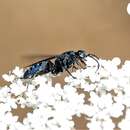Comprehensive Description
provided by Memoirs of the American Entomological Society
Aporus (Aporus) luxus (Banks)
Planiceps luxus Banks, 1914, Jour. N. Y. Ent. Soc, 22: 304 [Type: 2, California: National City, 15 May (VanDuzee) (MCZ, no. 13, 704)]. — Banks, 1919, Bull. Mus. Comp. Zool., 63: 242.
Planiceps assimilis Banks, 1917, Bull. Mus. Comp. Zool., 61: 100 [Type: 2, British Colombia: Penticton, 11 Aug. 1909 (J. B. Wallis) (MCZ, no. 10, 009)]. — Banks, 1919, op. cit., p. 242. New synonym.
Aporus (Aporus) luxus luxus Bradley, 1944, Trans. Amer. Ent. Soc., 70: 9091. — Wasbauer, 1960, Pan-Pac. Ent., 36: 175-176.
Aporus (Aporus) luxus assimilis Bradley, 1944, op. cit., p. 91. — Wasbauer, 1960, op. cit., pp. 175-177.
Wasbauer (1960) has argued for subspecific status for assimilis, but I cannot agree that 75% separation on one character in one sex is sufficient to justify a trinomen. This species has been recorded only once from Mexico, but it is doubtless not uncommon in northern Baja California and Sonora.
Female. — Length 8-14 mm. Black, the pubescence rather strongly bluish or violaceous, often silvery on sides of the lower front; fore wings fuscous, violaceous; hind wings lightly infuscated, darker apically. Erect setae and body pile essentially as described for the following species, concolor; erect setae on front femora absent or inconspicuous in specimens from southern parts of the range. Mandibles without a tooth on the lower margin. Clypeus about 3 X as wide as high. Front rather broad, MID .66-.72 X TFD; UID and LID subequal; ocelli in a broad triangle, POL considerably exceeding OOL. Vertex crest not very sharp, about as in concolor. Front femora moderately incrassate, measuring 2.3-2.7 X as long as wide. Fore wing with the second intercubital vein curved slightly on upper part, otherwise more or less straight and erect; SMC2 varying from 1.5 to 1.8 X as wide as high.
Male. — Length 5-9 mm. Black; pubescence strongly reflecting bluish, in small to large part silvery, the posterior slope of the propodeum with coarse, semi-erect silvery pile; wings lightly to moderately infuscated, darker apically. Inner orbits divergent above; POL subequal to or slightly exceeding OOL. Antennae more elongate than in related species, segment three 1.1-1.3 X as long as thick, segments 4-12 generally at least 1.5 X as long as thick. Wings as in female, but SMC2 often smaller, 1.3-1.6 X as wide as high. SGP relatively broad and truncate, with a high median ridge (Bradley, 1944, pi. IV, fig. 1). Genitalia with the parameres slender, much like those of concolor but somewhat elbowed (pi. IV, fig. 20 in Bradley, 1944).
Distribution. — British Columbia south to Baja California, east to Arizona and Utah. Wasbauer (1960) presented detailed distribution records, although some of them from the southern parts of the range probably apply to concolor. (Map 11.)
Mexican specimens examined. — 1 2 . Baja California: 1 2 , San Vicente, 8 July 1963 (JP) [CIS].
- bibliographic citation
- Evans, H.E. 1966. A Revision of the Mexican and Central American Spider Wasps of the Subfamily Pompilinae (Hymenoptera: Pompilidae). Memoirs of the American Entomological Society vol. 20. Philadelphia, USA

